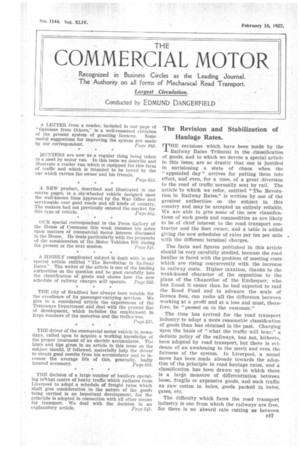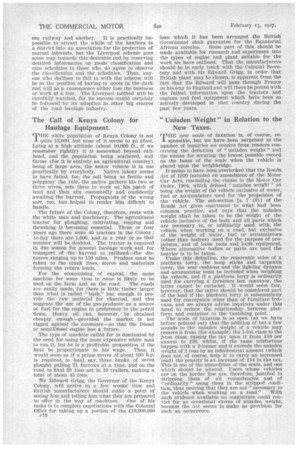A LETTER from a reader, included in our page of "Opinions from Others," is a well-reasoned criticism
Page 39

Page 40

If you've noticed an error in this article please click here to report it so we can fix it.
of the present system of granting 'licences. Some useful suggestions for improving the system are made
by our correspondent. Page 80.
HUNTERS are now as a regular thing being taken to a meet by motor van. In this issue we describe and illustrate a trailer van which is equipped for this form of traffic and which is intended to be towed by the car which carries the owner and his friends.
Page 863.
A NEW product, described and illustrated in our centre pages, is-a:six-wheeled vehicle designed upon the well-known •lines approved by the War Office and serviceable over geKid roads and all kinds of country. The makers had not previously entered the market for
this type of vehicle. Page 854. * * * OUR special correspondent in the Press Gallery of the House of Commons this week resumes his notes upon matters of commercial motor interest discussed in the House. He deals particularly with the prospects of the consideration of the Motor Vehicles Bill during
the present or the next session. Page 848.
A HIGHLY complicated subject is dealt with in our special article entitled " The Revolution in Railway Rates." The writer of the article is one of the leading authorities on the question and he goeS carefully into the classification of goods and shows how the new schedule of railway charges will operate. Page 852.
THE city of Bradford has always been notable for the excellence of its passenger-carrying services. We give in a considered article the experiences of the Tramways Department and deal with the present line of development, which includes the employment in is rge numbers of the motorbus and the trolley-bus.
l'age 857.
THE driver of the commercial motor vehicle is, nowadays, called upon to acquire a working knowledge of the proper treatment of an electric accumulator. The hints and tips given in an article in this issue on the subject should, if followed, materially help the driver to obtain good results from his accumulator and to increase the average life of this, generally, badly
treated accessory. Page 859.
TIIE decision of a large number of hauliers operating intthat centre of heavy traffic which radiates from Liverpool to adopt a schedule of freight rates which shall give consideration to the nature of the goods being carried is an important development, for the principle is adopted in connection with all other means for transport. We deal with the decision in an explanatory article. Page 849.
The Revision and Stabilization of Haulage Rates.
rriHE revisions which have been made by the -L Railway Rates Tribunal in the classification of goods, and to which we devote a special article In this issue, are so drastic that one is justified in envisioning a state of chaos when the "appointed day", arrives for putting them into effect, and even, for a time, of a great diversion to the road of traffic normally sent by rail. The article to which we refer, entitled "The Revolution in Railway Rates," is written by one of the greatest authorities on the subject in this country and may be accepted as entirely reliable. We are able to give some of the new classifications of such goods and commodities as are likely to be of chief interest to the road transport contractor and the fleet owner, and a table is added giving the new schedules of rates per ton per mile with the different terminal charges.
The facts and figures published in this article should be very carefully studied, because the road haulier is faced with the problem of meeting costs which are rising concurrently with the increase in railway costs. Higher taxation, thanks to the weak-kneed character of the opposition to the plans of the Chancellor of the Exchequer, who has found it easier than he had expected to raid the Road Fund and to advance the scale of licence fees, can make all the difference between working at a profit and at a loss and must, therefore, be "passed on to the customer."
The time has arrived for the road transport Industry to adopt a more reasonable classification of goods than has obtained in the past. Charging upon the basis of "what the traffic will bear," a definite policy of the railways, has not, hitherto, been adopted by road transport, but there is evidence of an awakening to the merit and even the fairness of the system. In Liverpool, a sound move has been made already towards the adoption of the principle in road haulage rates, and a classification has been drawn up in which there is a large measure of differentiation between loose, fragile or expensive goods, and such traffic as raw cotton in bales, goods packed in bales, cases, etc.
The difficulty which faces the road transport industry is one from which the railways are free, for there is no absurd rate cutting as between 0.7 one railway and another. It is practically impossible to attract the whole of the hauliers in a district into an association for the protection of mutual interests, but the Liverpool scheme goes some way towards this desirable end by reserving detailed information on goods classification and rate schedules to those who do agree to observe the classification and the schedules. Thus, anyone who declines to fall in with the scheme will be in the position of having to quote in the dark and will as a consequence either lose the business or work at a loss. The Liverpool method will be carefully watched, for its success would certainly be followed by its adoption in other big centres of the road haulage Industry.












































































































